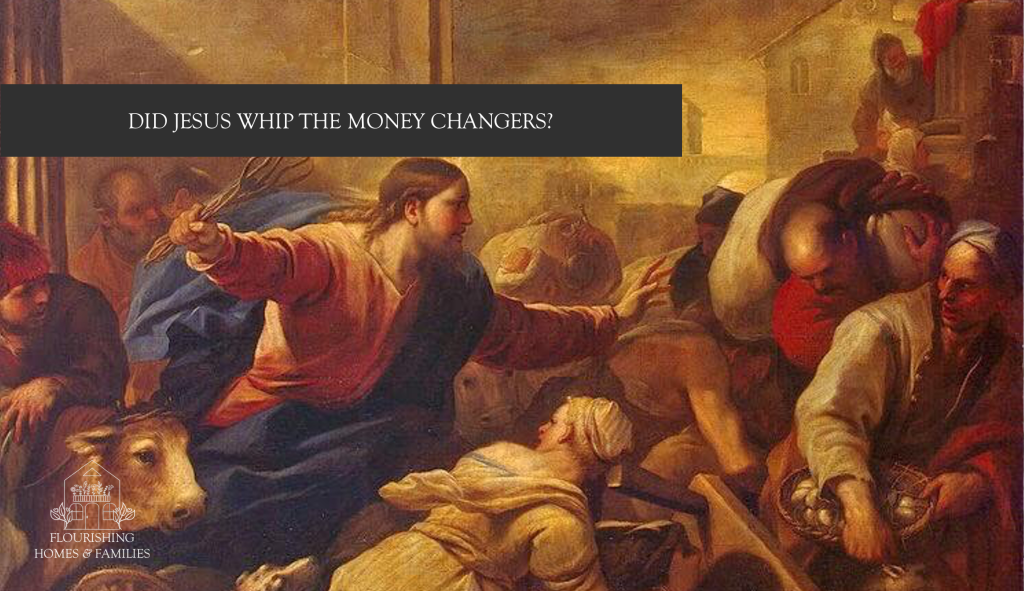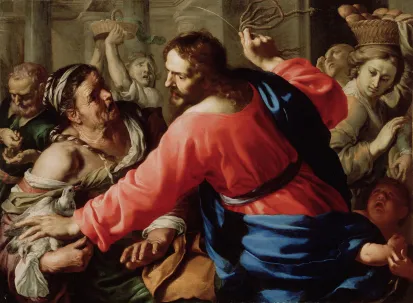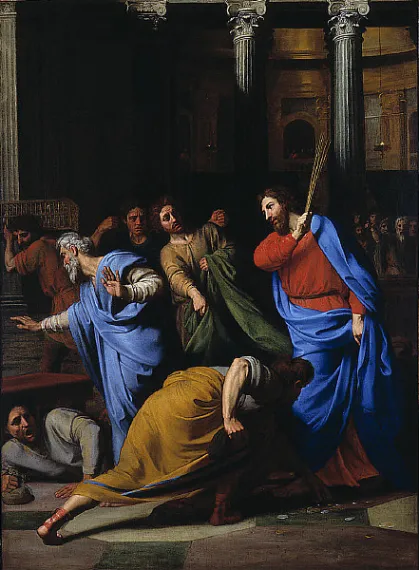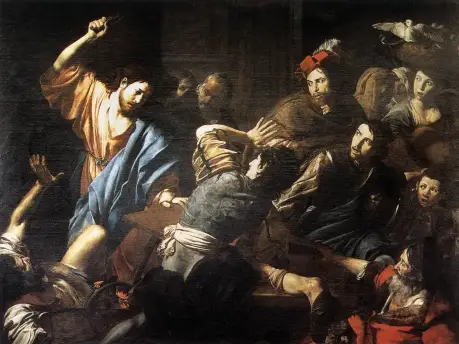
Sometimes Christians get really concerned that our culture is influencing how we interpret the Bible. I understand that concern and think it’s a very real issue. But I think we often forget that culture has been influencing how we understand Scripture for a very, very long time.
For example, the Romans thought they were the new covenantal nation just a few hundred years after Christ, likely because they were essentially an unstoppable force and they perceived themselves to be especially blessed by God because of their military successes. (Does that sound familiar?)
It’s really interesting to examine how art influences our interpretation of Scripture. A classic objection to Gentle Parenting is that Jesus whipped the money changers in the temple. But did He really?
Let’s look at what the Bible actually says about this story, and provide some clarity to common assumptions and culturally-influenced interpretation.
ASSUMPTION: JESUS WAS ANGRY AT THE MONEY CHANGERS
Scripture does not say Jesus was angry during this event. It’s certainly a possibility that was angry. We are reading it with our own preconceived ideas if we attribute His actions to anger, because Scripture is silent on whether or not He was angry.
We can tell from Scripture that He was not acting in a fit of rage or flying off the handle when He cleared the temple. We can be very nearly certain that He didn’t lose His cool and start going crazy. How do we know? John and Mark both suggest His actions may have been planned. In Mark 11:11-19, Jesus visits the temple but waits until the next day to do anything, and in John Jesus takes the time to make a whip from cords (John 2:15.) These both indicate that His actions were not impulsive or “knee jerk reactions” to the situation playing out at the temple.
ASSUMPTION: JESUS USED A WHIP ON THE MONEY CHANGERS
We do know that Jesus used a whip! But nothing indicates that He used it on people.
Scripture tells us there were livestock in the temple and that Jesus drove them out with a whip He constructed. This might sound a bit intense or dramatic, but it was the cultural norm to use a whip to herd and direct livestock. He was simply using a common tool for the common work of herding livestock.
ASSUMPTION: JESUS YELLED AT THE MONEY CHANGERS
Mark and Matthew clearly state He was teaching when this happened and that people were amazed at His teaching, and no Scripture indicates that He yelled at them.
I suspect most scholars view this interaction as an angry outburst because the Greek word for “overturned” the tables is “katastrephó” (catastrophe) and that sounds chaotic and crazy. I’m a bit rusty on my greek, but I think katastrephó is descriptive of the act of overturning, not the motivation behind the act. Additionally, the word does not inherently imply it was an outburst.
ASSUMPTION: JESUS WAS CLEANSING THE TEMPLE
This assumption is easy to make because most Bibles provide a story title that reads something like “Jesus cleanses the temple.” Here’s the thing we often forget, though: animals in the temple were a normal occurrence, and selling animals for sacrifice and paying a temple tax were required by Jewish law. The exchange of money itself would not have been cause for concern. Some commentators suspect that the focus had grown beyond service to profit and that unfair prices had essentially turned the temple courts into an exploitive marketplace.
Other scholars believe His motivation was symbolic. “Because Jesus drove out people and animals that were essential [to temple life], many scholars view his action not as a cleansing of the temple but as a symbolic act predicting its destruction. This puts Jesus in line with the actions of Israel’s earlier prophets and agrees with the words that John 2:19 has Jesus utter on this occasion: “Destroy this temple, and in three days I will raise it up.” Jesus seems to have envisaged that the temple would be removed to make room for whatever more perfect state of affairs would replace it in the kingdom of God.” (James F. McGrath, “Jesus and the Money Changers.)
If His actions were symbolic, there’s literally no reason He was acting in anger, and, of course, there is no Scriptural evidence to suggest He was.
WHY ARE THESE ASSUMPTIONS SO WIDELY BELIEVED?
We don’t usually think about how art impacts our interpretation of Scripture, but a vast majority of the art depicting this story shows Jesus with His hands raised, whip in hand, coming at the people.

Christ Cleansing the Temple by Bernardino Mei

Christ Expelling the Money-Changers from the Temple by Nicolas Colombel

Christ Driving the Money Changers out of the Temple Valentin de Boulogne
It’s easy to see how our understanding of this story may be influenced by the cultural understanding of cultures before us. Reading Scripture without cultural bias is very nearly impossible. But if we are to rightly divide the Word of Truth (II Timothy 2:15), we cannot be content only to understand Scripture through our cultural bias. We must be willing to ask hard questions of the text and ourselves and pray for wisdom as we seek the heart of God.












1 Comment